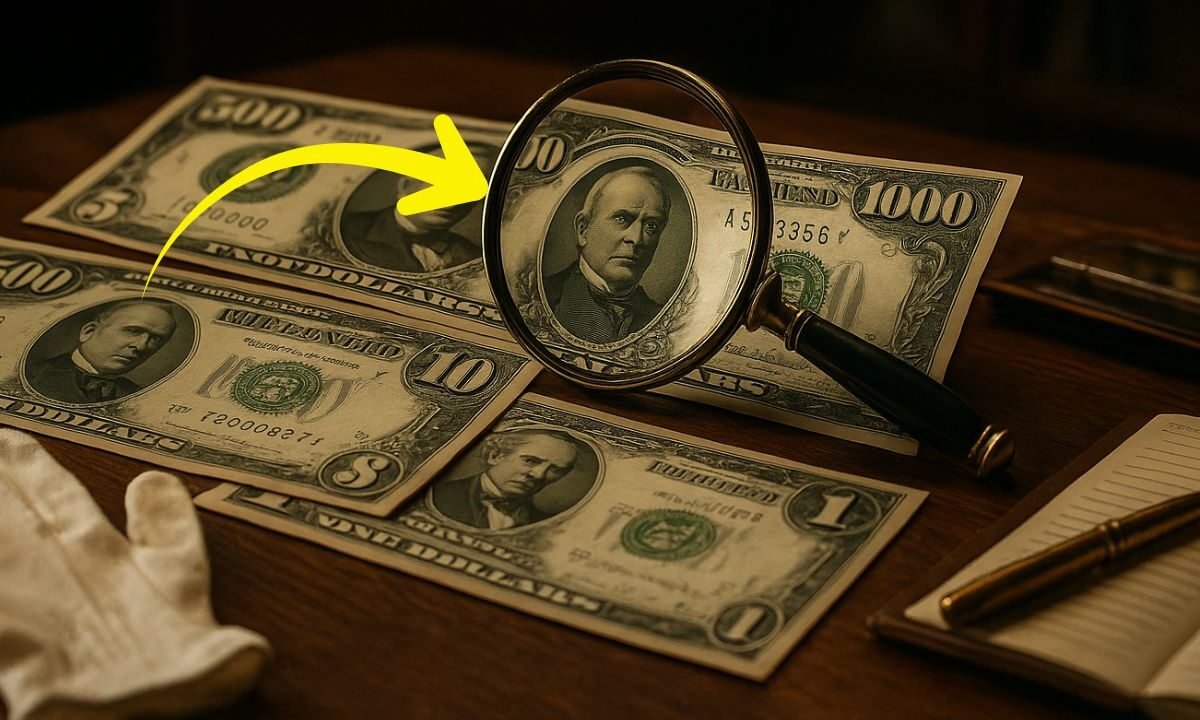Not all paper money is “just paper.” Certain U.S. banknotes become incredibly valuable because of short print runs, historic series, printing errors, or eye-catching serial numbers.
Below is a concise, up-to-date guide to the rarest notes you might actually encounter — plus what they’ve sold for recently and how to spot them.
Headliners You Should Know
1) 1890 “Grand Watermelon” $1,000 Treasury Note
This is the celebrity of U.S. currency. Its nickname comes from the large green zeros on the back that look like watermelons. Only a handful exist; one example is widely valued around $3.3 million after a record sale.
2) 1934 $10,000 Federal Reserve Note
These small-size high-denomination notes were made for bank transfers—not wallets—but survivors trade today.
In January 2024, examples graded Choice Uncirculated sold for around $270,000 and $453,600; in September 2023 another brought about $480,000.
3) 1934 $5,000 Federal Reserve Note
Still legal tender, yet prized by collectors. In April 2024 one certified example realised about $144,000; other recent sales reached between $120,000 and $192,000 depending on grade and district.
4) 1918 Large-size $500 Federal Reserve Note (Blue Seal)
These “big notes” (pre-1929 size) remain scarce in nice shape. Typical market ranges from low five-figures up to around $60,000 for better districts and grades.
5) 2013 “Duplicate Serial Number” $1 Star Notes (Project 2013B)
Here’s a wallet-find rarity: due to a BEP mix-up, some Series 2013 $1 (New York “B”) star notes were printed twice—once in Washington, D.C., and again in Fort Worth—creating identical serial-number pairs.
Vified matched pairs have traded up to around $25,000. Look for “Series 2013”, the “B” district seal, a star at the end of the serial, and a number within the published ranges.
6) Fancy Serial Numbers (ladders, solids, radars, low numbers)
Even modern $1–$100 notes can sell for multiples of face value if the serial pattern is special (for example 01234567 ladders, 00000032 lows, 77777777 solids). Collector guides explain which patterns bring premiums.
Quick ID (What to look for & recent prices)
| Note / Type | What Makes It Rare | How to Spot It | Recent Market Price (Examples) |
|---|---|---|---|
| 1890 $1,000 “Grand Watermelon” Treasury Note | Extremely low survivors; iconic design | Big green “000” on back; 1890 date | Valued around $3.3 million at top grade |
| 1934 $10,000 FRN | Discontinued high denomination | “$10,000” small-size note | Around $270,000–$453,600 in Jan 2024; record near $480,000 |
| 1934 $5,000 FRN | Scarce survivors; still legal tender | “$5,000” small-size note | Around $120,000–$192,000, common sale ~$144,000 |
| 1918 $500 FRN (Large-size) | Pre-1929 large note; low surviving grades | Blue seal; large format; 1918 date | Some grades around $6,250–$60,000 depending on district/grade |
| 2013 Duplicate-Serial $1 Star Note (B★) | Printing error created identical pairs | “Series 2013”, “B” district, star at end; matching twin required | Up to $25,000 per matched pair |
| Fancy Serial Numbers (modern) | Serial patterns create demand | Ladders, solids, radars, low/high numbers | Often $50–$7,500+ depending on pattern and grade |
How to Check Your Bills (Fast)
- Read the series & district: For the 2013 error note, confirm Series 2013, New York “B” bank, and a star symbol at the end of the serial. Then compare against known ranges for that error.
- Scan the serial number: Use collector lists to confirm if it’s a ladder, solid, radar, low or high number. Crisp, uncirculated notes always command the highest premiums.
- Grade matters: Professional graded notes cost far more — recent auction results show steep grade premiums.
If you are holding older notes—or even crisp modern bills—don’t spend them before you check them.
Historic issues like the 1890 “Grand Watermelon”, high-denomination $10,000 and $5,000 notes, 1918 large-size issues, and modern error star notes all prove that rarity, condition, and serial numbers can transform everyday currency into five-, six-, or even seven-figure collectible treasures.
A careful inspection—and professional grading when warranted—could reveal hidden value sitting in your wallet right now.
FAQs
Are $500, $1,000, $5,000 and $10,000 bills still legal tender?
Yes—they remain legal tender. However, they are no longer produced and most survivors are worth far more than face value to collectors.
What makes a modern $1 bill valuable?
Printing errors (such as duplicate serial issues) and fancy serial numbers (ladders, solids, radars, very low/high numbers) can bring hundreds to tens of thousands of dollars, especially in uncirculated condition.
How do I verify current prices?
Compare your note’s series year, bank district, serial number pattern, and condition/grade with recent auction results and trusted price-guides. Values may vary widely depending on demand and grade.

